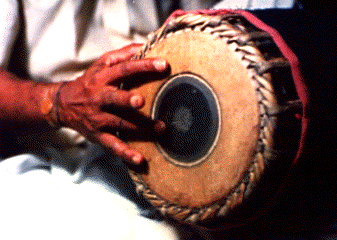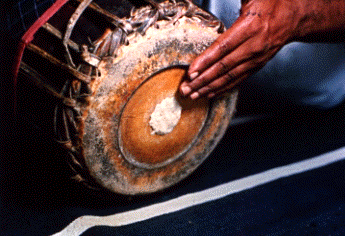The mridangam is the classical double
sided drum of South India and is used as an accompaniment for
vocal, instrumental and dance performances. The term mridangam is
derived from the sanskrit words "Mrid Ang" which
literally means "Clay-Body," indicating that it was
originally made of clay.
The present day mridangam is made of a single block of wood. It is
made either of Jackwood or Redwood. Jackwood has more fibrous
structure than the other types of wood.The packing of the fibres
is also very high.The pores present in jackwood is less when
compared to others. The pore size and distribution of the material
can be inversely proportional to the modulus of the wood.the
density of jackwood is also less when compared to other woods.
|
|
V = E/P
where V=velocity of sound, E=modulus, P=density
|
|
Therefore the
velocity of sound will be more when the pore size and distribution
and density is less. In some cases the core of the coconut or palm
tree is also used. It is a barrel-shaped double-headed drum, the
right head being smaller than the left. The two heads are made of
layers of skin. The heads are stretched by leather straps which
run along the sides of the body. The pitch is adjusted by moving
small wooden cylindrical pieces of wood between the wooden shell
and the leather straps.
|
|
The right head is made of three
concentric layers of skin. The innermost layer is not
visible. The outer ring is called the Meetu thol and the
inner ring is called the Chapu thol. The inner ring is
made of sheepskin and the outer skin is made of calf-hide.
At the center of the right head is a permanent spot of
black paste. This spot, called the Soru, is a mixture of
boiled rice, manganese and iron filings. This black spot
is responsible for the special tone of the mridangam
allowing emission of harmonics. Different harmonics of the
head are produced by various finger combinations.
|
 |
|
 |
The left head, known as the 'Toppi'
is made of only two layers; the inner one is made
of sheepskin and the outer one is made of buffalo
hide. Before playing the mridangam, a thick paste
made of semolina (sooji) and water is applied to
the center of this head. This is done to lower the
pitch and produce a bass sound on the left head.
This paste is scraped off after the performance.
The right head is tuned to the Tonic. On the rims
of the two heads there are spaces for the leather
braces to pass through. A small, smooth stone and
a small stick (wooden) are used to vary the pitch
of the heads by upward or downward strokes on the
rims. The pitch of the mridangam varies according
to its size. The larger the mridangam, the lower
the pitch and vice versa. The walls of the
instrument are 2/3 centimeters thick and give it
stability in the low frequencies.
|
|
|
Mridangam uses a single resonator.
Therefore the tension of the left and right sides of
mridangam are inseperable unlike the Tabla where the
tension of the left and right sides are seperate because
of the use of two resonators. Mridangam's single resonator
also produces an acoustic coupling between the two heads.
There is a hole in this outer covering
which exposes the main membrane below. This annular
membrane is much more prominent in the mridangam than in
the tabla. Pieces of straw are placed between the main
membrane and the annular membrane radically between the
two skins. This actually increases the dampening and acts
as a snare.
|
|



